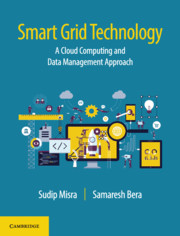Book contents
- Frontmatter
- dedication
- Contents
- Figures
- Tables
- Foreword
- Preface
- Part I Introduction
- Part II Cloud Computing Applications for Smart Grid
- 5 Demand Response
- 6 Geographical Load-Balancing
- 7 Dynamic Pricing
- 8 Virtual Power Plant
- 9 Advanced Metering Infrastructure
- 10 Cloud-Based Security and Privacy
- Part III Smart Grid Data Management and Applications
- Part IV Smart Grid Design and Deployment
- Index
6 - Geographical Load-Balancing
from Part II - Cloud Computing Applications for Smart Grid
Published online by Cambridge University Press: 20 October 2018
- Frontmatter
- dedication
- Contents
- Figures
- Tables
- Foreword
- Preface
- Part I Introduction
- Part II Cloud Computing Applications for Smart Grid
- 5 Demand Response
- 6 Geographical Load-Balancing
- 7 Dynamic Pricing
- 8 Virtual Power Plant
- 9 Advanced Metering Infrastructure
- 10 Cloud-Based Security and Privacy
- Part III Smart Grid Data Management and Applications
- Part IV Smart Grid Design and Deployment
- Index
Summary
The distributed architecture of smart grid facilitates micro-grids to provide electricity to the end-users in a distributed manner. Additionally, the micro-grids provide electricity to the customers using a combination of renewable and non-renewable energy sources. Therefore, each micro-grid has distributed generation facilities (such as combined heat power, solar, and wind), which act as the renewable and non-renewable energy sources. Consequently, micro-grids maintain a balance between real-time energy supply and demand to them. In order to have real-time information of the supply and demand, data centers need to be deployed for each micro-grid with bi-directional communication facility. In such a scenario, distributed load-balancing among the energy sources and data servers is required. Load-balancing is a technique by which massive load on a particular micro-grid can be reduced significantly.
Need for Load–Balancing in Smart Grid
There is a need to implement load-balancing in a smart grid due to the following reasons.
• As micro-grids provide electricity to customers in a distributed manner, the energy management policy implementation also takes place in a distributed manner at the micro-grids’ end. Therefore, it may happen that in a particular micro-grid's area, demand from the customers is very high. Consequently, real-time energy load on that micro-grid is very high, and it has to provide adequate electricity to the customers in order to meet the energy requirements of the latter. As a result, the micro-grid has to buy electricity from the main grid (through a market pricing policy) in order to meet the requirements. However, at the same time, it may happen that real-time demand is very low in another micro-grid. Therefore, there is an energy excess in that micro-grid. Consequently, it sells the surplus energy to the main grid. In such an energy exchange mechanism, a massive amount of energy is lost due to transmission loss. However, with the implementation of the load-balancing scheme, service areas of the micro-grids can be dynamically changed in order to maintain the balance between real-time energy supply and demand.
• Similar to the energy scarcity problem in a micro-grid's area, real-time information propagation may lead to the creation of a massive data load on the servers. With the help of bi-directional communication in the smart grid, customers communicate with the service providers for energy consumption. Therefore, real-time information propagation at the data centers also increases due to the massive energy demand from the customers.
- Type
- Chapter
- Information
- Smart Grid TechnologyA Cloud Computing and Data Management Approach, pp. 81 - 95Publisher: Cambridge University PressPrint publication year: 2018

